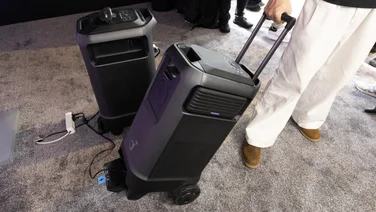To help us provide you with free impartial advice, we may earn a commission if you buy through links on our site. Learn more















- Optical zoom
- All-around object sensing and avoidance
- Hyperlapse and super resolution modes are impressive
- Camera still only has a 2/3in sensor
- Remote controller is fiddly to set up
DJI, like Apple, bestrides its industry like a colossus. It’s the biggest name in consumer drones by an absolute distance and its products deliver the goods consistently, year in, year out. The Mavic 2 Zoom, launched in mid-2018 alongside the Mavic 2 Pro, should ensure this dominance continues for at least another year.
That’s not necessarily because it’s particularly groundbreaking. It has a handful of headline features, which I’ll get onto in a moment, and there’s been a general honing of the overall design, but there are few visible differences between this and the Mavic Pro that was launched a couple of years ago.
That’s not a sign that DJI is getting lazy, however; more that it largely got the design right in the first place. Ever since, it has been steadily refining the highly successful formula of previous years, focussing on ease-of-use and predictable, safe flight, and coupling that with excellent image-quality from its cameras.
READ NEXT: The best camera drones to buy – our essential guide
DJI Mavic 2 Zoom: What you need to know
So, to those headlines. The Mavic 2 Zoom’s big thing, as you might have guessed from the name, is that its camera is endowed with an optical zoom. It’s only a 2x zoom but it’s better than no zoom at all. Plus it’s the only consumer DJI drone with a zoom to date.
Other big new features include all-around object avoidance sensors, where the previous model only had forward- and downward-facing object sensing. It has redesigned aerodynamics and a larger battery, enabling faster top speeds and longer battery life, and a new propeller blade design aimed at soothing that telltale bluebottle buzz.
Otherwise, the Mavic 2 is pretty similar to previous Mavic drones. It’s an easy-to-fly drone with a 4K camera that folds up small enough to squeeze into a medium-sized backpack. It’s best suited to keen amateurs rather than absolute beginners, but it’s easy enough to fly that you’d still be okay even if you’d never flown a drone before. What might put beginner pilots off is the price of £1,099.
DJI Mavic 2 Zoom review: Price and competition
It’s somewhat telling that the main competition for the Mavic 2 Zoom comes from within DJI’s own ranks and the competition is stiff.
The Mavic 2 Zoom’s predecessor, the Mavic Pro Platinum is our first port of call. It might not have a zoom or all-around object avoidance but it’s a brilliant drone and it’s £100 cheaper than the Zoom.
You can save even more if you opt for the original Mavic Pro at £860. Or if you don’t mind sacrificing flight time, the even more compact Mavic Air is available from around £720. Beginners seeking their 4K thrills in an even more lightweight package, however, might want to consider the Parrot Anafi, which offers 4K HDR recording for around £550.
Lastly, in the other direction along the price scale, you have the Mavic 2 Pro. Launched alongside the Mavic 2 Zoom, the Mavic 2 Pro is essentially the same drone but with a Hasselblad camera slung beneath it with a 1in sensor, adjustable aperture and the ability to record 10-bit HDR and 10-bit Dlog-M video.
DJI Mavic 2 Zoom review: Camera features
Why should you choose the Mavic 2 Zoom over its competitors, then? For me, it’s because it strikes the perfect balance between the more expensive Mavic 2 Pro with its semi-pro aspirations and its less fully featured siblings like the Mavic Air and Spark.
The price is just right and the camera’s new optical zoom facility adds enough to make it more attractive than cheaper rivals. More than that, though, it’s the camera that’s at the heart of everything good the Mavic 2 Zoom does. It lets you get closer to the action without any loss in quality and, importantly, allows you to zoom super smoothly, so with a bit of practise you can create fluid, professional-looking shots.















That’s not all, though. DJI has also used the zoom to boost the drone’s selection of automated image and video capture modes. In 4K the zoom is limited to 2X optical, but it is possible to zoom by up to 4x, also lossless, by dropping the resolution to 1080p. To be honest, you could shoot in 4K and crop using your video editing software to achieve the same effect, but for a quick and dirty zoom it’s pretty effective.
The new super-resolution mode uses the optical zoom to capture a series of images and overlay and stitch them together to create huge 40-megapixel aerial tapestries. The Mavic 2 Zoom also has Dolly Zoom mode that creates a cinematic change in perspective by zooming into a subject at the same rate as the drone flies away.
Possibly the most exciting new camera mode, though, is Hyperlapse which allows users to create automated moving time-lapse images by shooting a series of RAW images at regular intervals along a set path of movement. This isn’t the easiest feature to get to grips with. In circle mode (one of three different modes), I found it wouldn’t let me shoot unless I was flying a certain distance from the subject I wanted to circle around.















You’ll also need to allow a lot of space to complete your manoeuvre or the drone will encounter an obstacle and terminate halfway through. However, as a quick Google reveals, it’s possible to achieve some absolutely incredible results if you have the patience and are willing to persevere with it. Finally, the Mavic 2 Zoom’s has an improved tracking system that will allow it to follow people and objects even if they’re temporarily obscured behind obstacles like trees or bridges.
Other than this, the specifications of the DJI Mavic 2 Zoom look remarkably similar to the DJI Mavic Pro and Pro Platinum. The camera uses a 1/2.3in sensor to shoot 12-megapixel stills with a static aperture of f/2.8 and captures 4K video at a maximum of 30fps. Only the Mavic 2 Pro gets a sensor upgrade, to 1in, although it loses the zoom capability in the process.
DJI Mavic 2 Zoom review: Image quality
The key difference between the Mavic Pro/Pro Platinum and the 2 Zoom is the bitrate that video records at, which is up from 60Mbit/sec to 100Mbits/sec here. It ensures your footage is less compressed and smeary. In fact, image quality, whether zoomed in or out, in stills or in video, is absolutely superb.
The Mavic 2 Zoom’s camera is capable of capturing an insane amount of detail, great colours and the zoom allows you to keep your distance while capturing a closer view of a scene. Automatic exposures are expertly judged, footage doesn’t smear or wobble when panning left and right, even at speed, and the zoom is buttery smooth.















^ Super resolution pictures (left, cropped in) allow you to capture images much more detailed than the 12-megapixel camera can capture natively (right)
And although I don’t see much point in the 4x “lossless” zoom in 1080p, Super Resolution photos work really well, adding extra detail and scale to your aerial photographs. I tried it out on a few scenes and found it difficult to catch it out – it’s virtually impossible to see the joins.
In short, even if you don’t know what you’re doing, the Mavic 2 Zoom is capable of producing near-professional grade results. And if you do, the sheer range of manual controls and automated modes available means the quality of video and stills it’s able to produce are nothing short of stunning.
If you look really hard, right close up, you could criticise the fact that the Mavic Pro’s footage and images don’t look much better than a really good smartphone camera. The size of the 1/2.3in sensor is the limiting factor here. But that really would be churlish, especially considering this superlative drone costs the same as an iPhone Xs Max.















DJI Mavic 2 Zoom review: Flying and setup
So that’s the camera done and dusted. The DJI Mavic 2 has a few new features on the flying front that pilots will welcome. First up is quieter flying. Thanks to redesigned rotor blades that are now turned up slightly at the ends, a bit like the winglets you see on modern passenger planes, the Mavic 2 Zoom is even quieter in the air than the original Mavic Pro.
It still buzzes like an overgrown hornet when you’re up close, of course, but it isn’t whiny like some drones and, once you’ve gained a bit of altitude you’ll barely be able to hear it. DJI has also improved aerodynamics in general so the drone is quicker and added a higher capacity 3,950mAh battery to keep flying time similar, despite all the extra features.
The Mavic 2 Zoom has a top speed of 72km/h in Sport mode versus 65km/h for the Mavic Pro Platinum and Mavic Pro. It gives you 31 minutes of flight time in non-windy conditions versus 30 minutes for the Pro Platinum and 27 minutes for the original Mavic Pro. All good stuff.















Next up, object avoidance, which has seen an even bigger upgrade. The Mavic 2 Zoom now has two front-facing sensors, a pair of sensors at the rear and one on each flank, as well as the downward-facing camera and distance sensors that help it land smoothly and hover in place without drifting.
I tested it out by flying the drone by first flying it at myself and then at a large hedge, forwards, sideways and backwards and it worked perfectly in every instance – as you’d hope. Helpfully, the remote emits a loud beep as you approach an object, a bit like the parking sensors in a car, so you know the system is working.
One peculiarity, though, is that the side sensors only come into play when you’re in one of the Mavic 2 Zoom’s tracking modes, not when you’re flying with the sticks. This is indicated by a small circular icon at the top of the screen surrounded by a series of segments indicating which sensors are active but you can’t override it, which is a shame. To me, it seems an unnecessary risk not running all the sensors all the time. You’ve got the new sensors; why not use them?















Finally, the Mavic 2 Zoom also benefits from DJI’s latest Ocusync 2.0 transmission system, which gives the drone a range of up to 8km and 1080p live streaming, either to the screen of your phone or the optional FPV goggles.
Otherwise, the DJI Mavic 2 Zoom flies just as competently as its predecessors. It’s predictable, responsive and easy to fly and it feels even more solid in the air than the compact Mavic Air. The included remote control is a tad fiddly to connect to start with, which is something DJI needs to address but, once your smartphone is in place, it’s comfortable in the hand and the sticks feel precise and progressive.
Plus, as with the Mavic Air, the sticks are removable and slot into a pair of small rubber berths beneath the folding handgrips, so there’s less chance of damaging them when you pop the drone in a bag.















DJI Mavic 2 Zoom: Verdict
You might have expected, given the extra zoom facility, the extra sensors and new design, that DJI would whack a huge premium on the DJI Mavic 2 Zoom. Amazingly, though, it’s the same price as the original Mavic Pro. Given how much more it offers for the money, I had to double check to see if I’d read it right.
That’s cast into stark relief when you realise that I’ve only really covered the headline improvements in this review. Examine the small print and you’ll see that almost everything about the DJI Mavic 2 Zoom is better than its predecessor, from the mechanical compensation and controllable range of the gimbal through the closest distance objects can be sensed (0.5m vs 0.7m) to the minimum operating temperature (-10°C vs 0°C).
This is a first class consumer drone and the best of DJI’s current offering I’ve currently tested. I haven’t had the opportunity to look at the Mavic 2 Pro yet with its 1in sensor, adjustable aperture and HDR filming capabilities but it is significantly more expensive than and, for me, the 2 Zoom strikes a better balance between flexibility, accessibility and price. No two ways about it, the DJI Mavic 2 Zoom is the best consumer drone money can buy.








